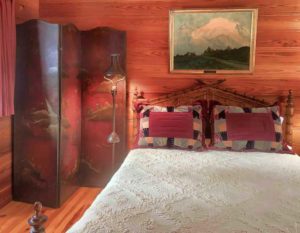Small Home Gazette, Spring 2016
Answers to Your Toughest Bungalow Questions: folding screens and plant list
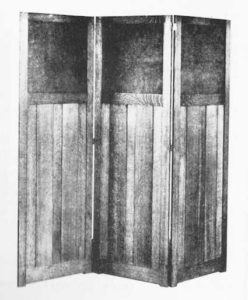
A folding screen from Stickley’s 1919 furniture catalog. Described as: “No. 91 Screen. Sheepskin Panels. Height 68 in., 3 panels, width of each 22 in.”
A: Folding screens go way, way back, originating centuries ago in China and appearing throughout history. They were often elaborate, many-paneled affairs, ornamented with intricate scenes crafted from layers of lacquer and carved clay.
Some of the first uses for screens were rather practical. They were used to prevent drafts in homes. They were used for privacy, as with your grandfather, and often used as a dressing screen for ladies. Screens could become a portable wall. In houses with servants, for example, they could be used in the corner of the dining room to obscure the view into the butler’s pantry or kitchen.
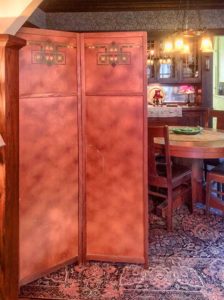
A vintage folding screen separates a bungalow’s living and dining rooms. The frame is oak; the panels fiberboard. An airbrush technique was used to apply a stenciled design and an overall mottled effect.
Bungalow floor plans were more open and casual than those of Victorian homes, but that didn’t mean there wasn’t the occasional need to demarcate a smaller area. A 1916 article in Keith’s Magazine of Home Building entitled “Inside the Home,” offered advice on how best to design the opening between the living and dining rooms. “It is always advisable to be able to shut off the dining room on occasion, …many people use the columned opening, but in which case a large folding screen, which can be interposed, is absolutely essential.”
You can still find vintage screens made of carved or painted wood, or cheaper fiberboard. They were often painted or stenciled. More substantial versions were covered in leather, or even hammered metal. Lighter versions consist of a frame with pleated fabric panels. Gustav Stickley offered oak screens with panel insets of sheepskin (which he considered his softest and most flexible leather) or Japanese grass cloth (a loosely woven fabric made from plant fibers such as jute of hemp).
A compact folding screen would certainly look at home in a bungalow today. It could be set up to partition a large room or change the interior features of the space—for example, to section off an office area or hide a flat-screen TV. Other reasons to use a screen include: to direct foot traffic, create a foyer, create coziness, add a splash of color, or add a decorative backdrop.
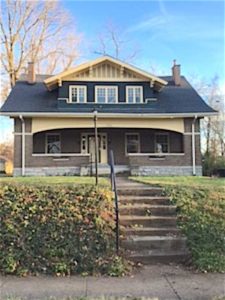 Q: I just read your wonderfully informative article [tinyurl.com/gvn95fq] on your website about appropriate plantings for the bungalow period. I recently purchased a 1915 bungalow, and according to the original blueprints, there was once a “flower box, lined with tin” that sat beneath the second-story dormer windows on the porch roof. I am doing a whole house renovation/restoration and would like to bring this flower box back. Any suggestions for plants? My home will be on a tour in August, and I want to make sure that everything is period specific and just right!
Q: I just read your wonderfully informative article [tinyurl.com/gvn95fq] on your website about appropriate plantings for the bungalow period. I recently purchased a 1915 bungalow, and according to the original blueprints, there was once a “flower box, lined with tin” that sat beneath the second-story dormer windows on the porch roof. I am doing a whole house renovation/restoration and would like to bring this flower box back. Any suggestions for plants? My home will be on a tour in August, and I want to make sure that everything is period specific and just right!
A: What a charming bungalow! We certainly understand your excitement and applaud your desire to restore your home’s original elements. As far as suggestions for plants, we have a few.
Here’s a link—tinyurl.com/zruf2fz—to an article that ran in the Winter 2009 issue of this newsletter, titled “Tips for Creating Successful Window Box Planters,” written by David C. Zlesak, Extension Educator, Horticulture, University of Minnesota Extension. It’s a terrific article, and one that we consult every spring. It includes advice on basic container gardening; suggestions on choosing plants with similar light, water and soil acidity requirements; and recommendations for specific plants. Of course, this article is geared toward plants that do well in Minnesota’s climate, but many would also thrive in Kentucky.
Also, here’s a link to an article titled “Window Boxes and Their Care” that was published just a year after your house was built, in a 1916 issue of Keith’s Magazine: tinyurl.com/gucc9fv.
Finally, below is yet another list of plants, vines and flowering shrubs prepared by Deborah Brown, retired Extension Horticulturist, University of Minnesota. In 2004 she gave a presentation to the Bungalow Club called “Gardening for Bungalows and Arts & Crafts Style Homes in Minnesota.”
Perennials (foliage may be as important as flowers):
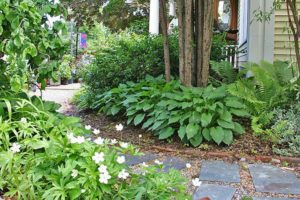 Artemesia (wormwood)—grown for silvery foliage
Artemesia (wormwood)—grown for silvery foliage
Balloon Flower (Platycodon)
Bleeding hearts
Chrysanthemums
Columbine—wild and cultivated varieties
Cupid’s Dart (Catanache, blue flowers)
Daylilies—tawny daylily or lemon daylily rather than “meatier” hybrids
Daffodils
Ferns—suitable only for shade
Hostas (but not too fancy)—primarily for shade (used to be called funkia or plantain lilies)
Iris—both Siberian iris and tall bearded (German) iris
Oriental poppy—red-orange poppies common in bungalow heyday
Peonies—fern-leaf peonies, single cultivars, or newer cultivars that stand up to rainfall
Phlox—common magenta and named cultivars (good ones are ‘David,’ ‘Franz Schubert,’ ‘Bright Eyes,’ ‘Laura’ and ‘World Peace’)
Perennial sweet pea (Lathyrus latifolia)
Shasta daisies—relatively short-lived perennial in Minnesota; ox-eye daisy more reliable but considered a weed by many gardeners, as it self-seeds aggressively
Flowering annuals and biennials:
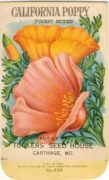 Ageratum—tall, old-fashioned such as ‘Blue Horizons’
Ageratum—tall, old-fashioned such as ‘Blue Horizons’
Bachelor’s buttons—tall, old-fashioned such as ‘Blue Boy’
Balsam (Impatiens balsamina, for shade)—not to be confused with standard impatiens
Bells-of-Ireland
Black-eyed susan vine (Thunbergia)
California poppies
Cosmos—tall pink, white, and rose varieties (‘Sonata Mix’ is knee high)
Cleome (spider flower)—older cultivars very tall; newer ones more compact (‘Sparkler’ series)
Cups and saucers, a biennial campanula—blooms the second year, then dies
Feverfew—self-seeds prolifically
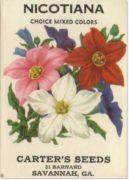 Four o’clocks—flowers open late in afternoon, very fragrant at night
Four o’clocks—flowers open late in afternoon, very fragrant at night
Geraniums—red, pink or white
Heliotrope (‘Marine’ and others)—incredibly fragrant plant with large clusters of tiny blossoms
Hollyhocks—biennials that will yield blooming plants every year once well-established
Kiss-me-over-the-garden-gate (Persicaria orientale)
Love-in-a-mist (Nigella)
Love lies bleeding (Amaranthus)
Marigolds
Nicotiana sylvestris—tall flowering tobacco; extremely fragrant pendulous, white, tubular blooms
Pansies—newer cultivars may last for months in semi-shade
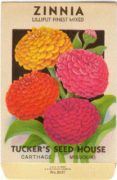 Petunias
Petunias
Scabiosa or pincushion flower
Snapdragons—especially tall varieties (‘Rocket’ and others)
Sweet alyssum—white cultivars are most vigorous
Sweet peas—for morning sun or dappled shade; choose early bloomers to avoid summer heat
Zinnias—‘Cut and Come Again,’ ‘Granny’s Bouquet,’ and ‘Persian Carpet’; for more compact, modern “groundcover” zinnias, look at Profusion series
Vines for arches, gate posts, pergolas:
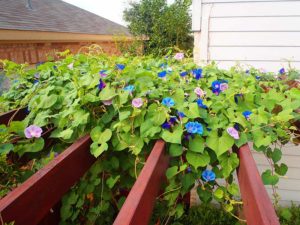 Boston ivy (Parthenocissus tricuspidata)—green ivy-like leaves
Boston ivy (Parthenocissus tricuspidata)—green ivy-like leaves
Clematis ‘Jackmanii’—deep purple flowers, may die back to ground some winters
Hardy climbing roses—‘William Baffin,’ ‘John Cabot’ and ‘Henry Kelsey,’ part of the Canadian Explorer series; must be trained onto sturdy supports
Kentucky wisteria (Wisteria macrostachya)—‘Aunt Dee’ or ‘Blue Moon’ (flowers and clusters smaller than Japanese wisteria)
Morning glories, especially blue
Virginia creeper (Parthenocissus quinquifolia)—grown for foliage; brilliant red fall color
Wild riverbank grape (Vitis riparia; also, beta grape)
Flowering shrubs:
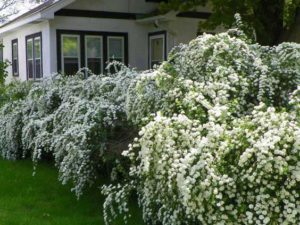 Anthony Waterer’ spirea—produces flat clusters of tiny rosy colored flowers on new wood
Anthony Waterer’ spirea—produces flat clusters of tiny rosy colored flowers on new wood
Bridal wreath spirea—large shrub with gracefully arching stems, covered with small clusters of white flowers in June
Forsythia—must be ‘Northern Sun,’ ‘Northern Gold’ or ‘Meadowlark’ for blooms every spring
Honeysuckle ‘Honey Rose’—others are severely attacked by honeysuckle witches’ boom aphids
Hardy roses—Rugosa roses would be historically accurate (red, rose, white); also modern shrub roses from the Explorer and Parkland Canadian series—many excellent choices
Hills of snow hydrangea (Hydrangea arborescens)
Tree hydrangea (Hydrangea paniculata)
Lilacs—common purple and common white; also named cultivars such as ‘Ludwig Spaeth’ (deepest purple blossoms)
Viburnums: American or European highbush cranberry—including the cultivar ‘Roseum,’ the common snowball viburnum; also, wayfaringbush viburnum (Viburnum lantana)
Weigela—some new cultivars aren’t as “weedy” as older ones; ‘Wine and Roses’ is compact; ‘Red Prince’ is more showy, but gets very large
Happy gardening!









